The
Home Page Selection
If
you require further information on any
print featured here, please contact
us.
When
a print has been sold it will be marked
as Sold.
A
growing archive of selections
from previous Home pages is featured in
the
Home
Page Selection Archive |
|
See
also :
Click
on a thumbnail (left)
to link directly with the entry for that
print, or scroll down to view all the selected
prints from the current Home
Page.
Images
are not to relative scale (see stated dimensions) and also at only modest resolution. If you wish to view extracts of an image at higher resolution, please Contact us.
|
|
|
|
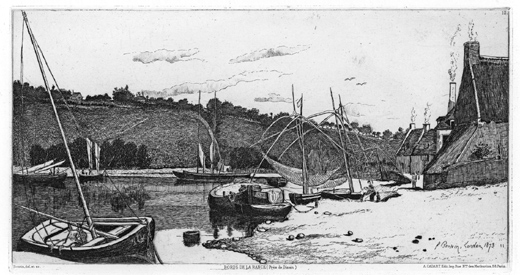
| |
FRANÇOIS BONVIN
Paris 1817 – 1887 St Germain-en-Laye
A realist painter and etcher. In 1859 when Whistler and his friends
Fantin Latour and Alphonse Legros (le Société des Trois, and all three
subsequently members of the Société des Aquafortistes),
were rejected at the Salon, Bonvin exhibited their ‘refused’ paintings
in his studio.
Bonvin too was a member of the Société des Aquafortistes from 1862,
though, like Whistler, none of his etchings were published in the specific
Society albums. He was however well represented in Cadart’s continuation
series L’Illustration nouvelle, his plates appearing in the 1874, 1875 and
1880 issues. He had one etching in Cadart’s L’Eau-forte en 1874.
Bonvin, perhaps because of his friendship with Legros and Whistler, or
because of the political situation in Paris after the Franco-Prussian War,
visited London in the 1870’s. In 1871 he is recorded as a visitor to the
Print Room of the British Museum ten times, to look at prints in the
collection and was in the city again in 1873 when he etched the plate of
Bords de la Rance.
Bords de la Rance (Près de Dinan)
163 x 309 mm
Original etching, 1873.
The plate signed and dated London 1873
within the image.
Lettered in the lower plate border with the title etc.,
as issued 1874 by Cadart in L’Eau-forte en 1874.
On cream laid
paper.
£150
Return to top ^ |
|
|
|
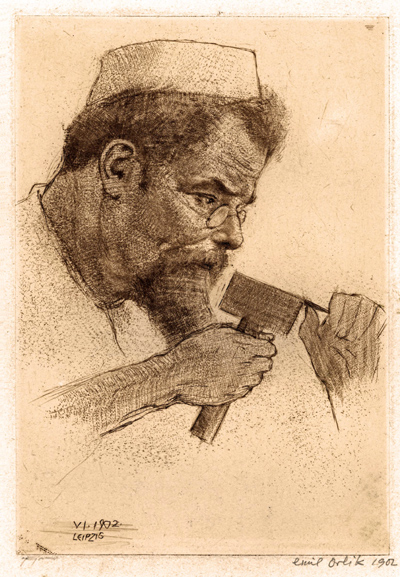 |
|
EMIL ORLIK
Prague 1870 – 1932 Berlin
Orlik took up etching while a student at Munich in 1893.
In 1896 he and his life-long friend Bernhard Pankok started making
colour woodcuts, influenced by Japanese prints.
From 1898 Orlik travelled in Europe and in 1900 made his first visit
to Japan to study Japanese woodblock printmaking.
He joined the Vienna Secession in 1899 while visiting the city and
exhibited a number of woodcuts with Japanese subjects in their third
exhibition.
After Orlik was given a major exhibition in 1901 with Paul Cassirer in
Berlin he would settle there permanently.
From 1904 to 1930 was head of the graphic department of the Academy
of the Kunstgewerbermuseum.
He played a leading role in the Berlin Secession until he resigned in 1913.
Max Klinger bei der Arbeit
Glockner 220
196 x 135 mm
Original drypoint and roulette, 1902.
The plate dated and inscribed Leipzig.
Signed and dated in pencil by Orlik.
Printed in sanguine on stout wove by
Otto Felsing and signed by him in pencil as printer.
Sold
Max Klinger at work, in the year his sculpture of Beethoven dominated the
special exhibition devoted to Beethoven at the Vienna Secession.
Both Klinger and Orlik were members of the Vienna Secession.
Return to top ^ |
|
|
|
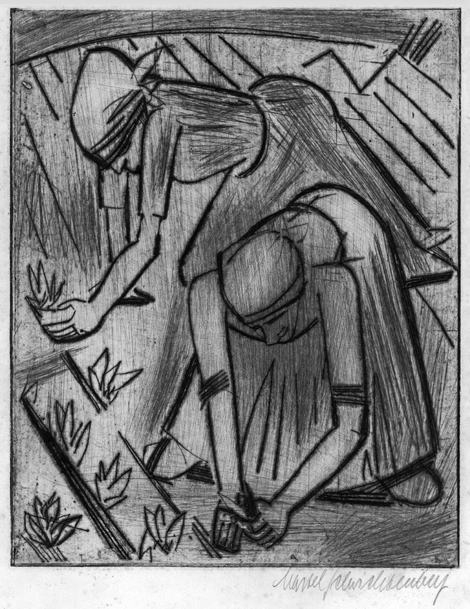 |
|
MARTEL SCHWICHTENBERG
Hannover 1896 – 1945 Sulzburg, Baden
After exhibiting in Hannover at the Folkgang Museum, Schwichtenberg
was commissioned by the Bahlsen biscuit factory as a graphic designer and
supported by this contract was able to set up her own studio in Charlottenburg,
Berlin, where she joined the November Group – and the Deutscher Werkbund -
and adopted the name ‘Martel’ after the French cognac (she had been named by
her parents Justine Adele Martha).
In the 1920’s she became friendly with the die Brücke artists, Pechstein and
Schmidt-Rottluff, who sponsored her membership of the Novembergruppe.
She exhibited with the group through the 1920’s.
In 1929 she participated in the exhibition Die Frau von heute (The Woman of
Today), organised by the Berliner Verrein der Künstlerinnen (the Berlin
Association of Women Artists, which had been established 1867).
During the early 1920’s Martel Schwichtenberg spent several summers in
Pomerania where she did powerful etchings and woodcuts of the peasants
and fishermen.
(Women planting seedlings)
243 x 195 mm
Original drypoint, c1923.
Signed in pencil.
On stout cream wove.
The reverse time stained and foxed, just slightly
affecting the margins recto.
Sold
Return
to top ^ |
|
|
|
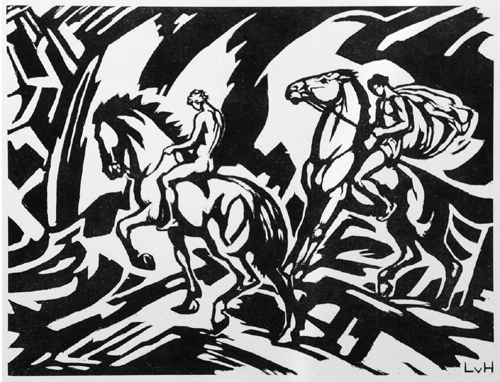 |
|
LUDWIG VON HOFMANN
Darmstadt 1861 – 1945 Pillnitz
A founder member of the Berlin Secession, von Hofmann was also a
member of the national Deutscher Künstlerbund.
His earlier jugendstil, symbolist and arcadian landscapes with nude figures
took on a more expressionist character in middle life, a period when
von Hofmann’s focus shifted towards graphics.
Von Hofmann was Professor at Weimar in 1903, where he was a member
of the avant-garde literary and artistic group around Count Harry Kessler
until he moved in 1916 to Dresden to be Professor at the Academy;
a post he held till 1931.
Reiter Rider
303 x 400 mm
Original woodcut, 1920.
The block signed with initials.
Issued by the Gesellschaft für verviefältigende Kunst, Vienna, 1920.
On cream laid paper.
Sold
Return
to top ^ |
|
|
|
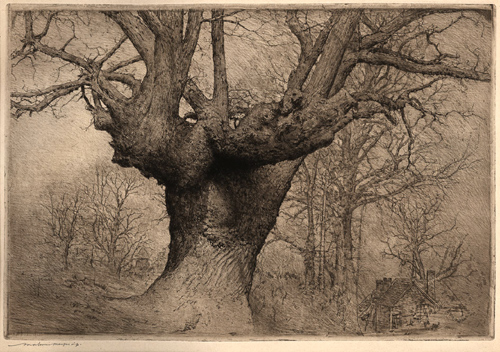 |
|
MORTIMER MENPES R.E., R.B.A., R.O.I., F.R.G.S.
Port Adelaide, South Australia 1855 –
1938 Iris Court, Pangbourne
Menpes settled in England in 1875.
After exhibiting in the R.E. ‘test’ exhibition he was elected a Fellow in 1881.
He served on the R.E. Council 1886-93 with Haden, Strang, Short &
Alfred East.
Menpes had begun etching in 1879 and was active in the medium through
the 1880’s and ‘90’s, but it was only after 1900 that he concentrated on
etching intensively, almost exclusively (his etched oeuvre would total over
700 plates), though he exhibited less, perhaps partly due to his resigning from
the R.E. in 1913 when they refused to hang 3 of his 5 submitted prints.
Up to that date he had exhibited 94 etchings with the society.
Menpes was elected to the Royal Society of British Artists in 1885 (though he
resigned 1888).
He was also a member of the New English Art Club from 1886;
the Royal Institute of Painters in Watercolours 1897;
the Royal Institute of Oil Painters 1898;
and of the Royal Geographical Society from 1890.
A giant Oak
Morgan 294 only state
280 x 410 mm
Original drypoint, 1907-08.
Signed in pencil.
Printed by the artist, in brown-black ink on thin cream wove paper.
Sold
Exhibited in 1908 at the Fine Art Society.
Return
to top ^ |
|
|
|
|
|
|
|